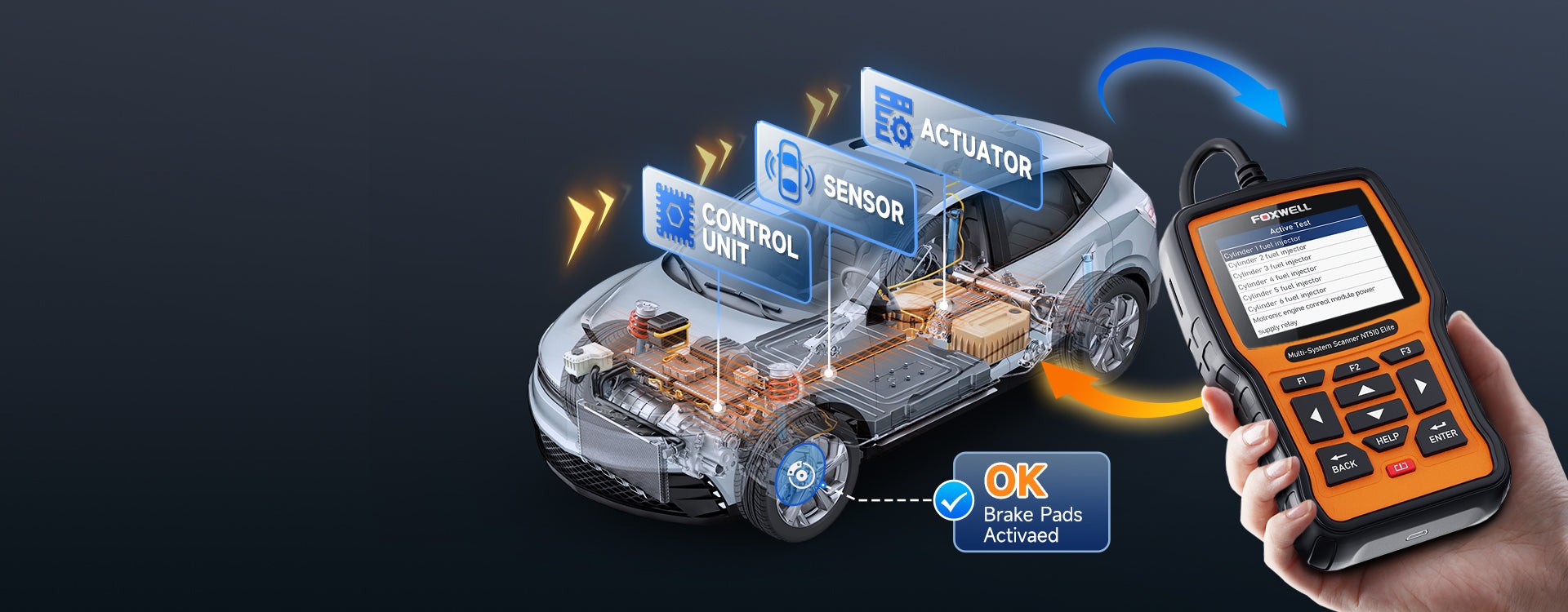Imagine this: It’s a cold winter morning, and you need to get to work quickly. Your car cranks but refuses to start; the battery is dead. After jump-starting your vehicle and purchasing a new battery from the nearest auto parts store, a new problem arises: the electrical system starts behaving erratically, with warning lights illuminating your dashboard – all because you forgot to register the new battery with the onboard computer. This is where an automotive OBD2 scanner with battery registration capabilities can be a lifesaver.
Alt text: Automotive OBD2 scanner performing active test, highlighting its diagnostic capabilities for modern vehicles.
Understanding OBD2 Scanners and Battery Registration
An OBD2 scanner is a tool that connects to your car’s onboard diagnostic system. It’s designed to read and clear trouble codes, monitor vehicle performance, and perform various diagnostic functions. Battery registration is a specific function found in some advanced OBD2 scanners, and it becomes particularly important when you replace your car battery in modern vehicles.
Modern cars, especially those with start-stop systems and advanced energy management, require battery registration. This process informs the car’s computer system that a new battery has been installed.
The Critical Importance of Battery Registration
Replacing a car battery in a modern vehicle is not as simple as just swapping out the old one. The vehicle’s Battery Management System (BMS) needs to be aware of this change. Registering your new battery ensures the BMS can properly manage charging and discharging cycles, which is crucial for several reasons:
Optimizing Battery Performance and Lifespan: Proper battery registration allows the BMS to accurately match its operating parameters to the characteristics of the new battery. This ensures the battery is charged efficiently and effectively, meeting the vehicle’s power demands. This adjustment is vital to prevent overcharging or undercharging, both of which can significantly shorten the battery’s lifespan and lead to premature failure.
Preventing Electrical System Issues: If a new battery isn’t registered, the vehicle’s charging system might continue to operate under the parameters set for the old battery. This can lead to incorrect charging voltages and currents. Your car’s electrical system relies on precise data from the BMS for correct operation. Without proper registration, you might experience a range of electrical problems, from flickering lights and malfunctioning electronic components to more severe issues like complete system failures or error messages on the dashboard.
Resetting the Battery Management System (BMS): Battery registration effectively resets the BMS. This reset clears any stored data and error codes related to the previous battery’s age and condition. By calibrating the BMS with the new battery’s information, the system can provide accurate diagnostic information and ensure the vehicle operates smoothly and reliably. This fresh start for the BMS is essential for accurate monitoring and management of the new battery.
Enhancing Fuel Efficiency: For vehicles equipped with start-stop technology and regenerative braking, battery registration plays a direct role in fuel efficiency. The BMS controls when the engine should shut off and restart based on the battery’s state of charge and health. Accurate battery information ensures these start-stop decisions are made efficiently, maximizing fuel savings. An unregistered new battery can lead to inefficient start-stop operation, reducing fuel economy.
Ensuring Safety and Reliability: Correctly registering your battery contributes to overall vehicle reliability and safety. By minimizing the risk of unexpected electrical malfunctions and breakdowns, battery registration helps ensure that all vehicle systems function as intended. This reliability is paramount for daily driving and especially important for long journeys, providing peace of mind and reducing the chance of being stranded due to battery-related issues.
When Should You Use the Battery Registration Function?
The need for battery registration isn’t just a one-time event after replacement. Here’s when you should consider using the battery registration function on your OBD2 scanner:
After Every Battery Replacement: This is the most critical time to use the battery registration feature. Whenever you install a new car battery, registration is paramount. Failing to register a new battery can lead to improper battery management and potentially damage the vehicle’s electrical system over time. Always make battery registration a mandatory step after replacement.
As Part of Regular Vehicle Maintenance Checks: Incorporate battery status checks and potential re-registration into your regular vehicle maintenance schedule, ideally every 6 to 12 months. Even if you haven’t replaced the battery, using a scanner to monitor battery health and ensure the BMS is functioning correctly can help proactively identify potential issues and maintain optimal battery performance. This proactive approach can prevent unexpected battery failures.
When Experiencing Electrical Issues: If you notice any unusual electrical behavior in your vehicle, such as flickering headlights, erratic warning lights, unexplained error messages, or sudden electronic component shutdowns, consider battery re-registration. Sometimes, the BMS may lose calibration or encounter glitches. Re-registering the battery can sometimes resolve these issues and restore normal electrical system operation.
Before Long Road Trips: Prior to embarking on long road trips, it’s wise to perform a vehicle check, including battery status. Using an OBD2 scanner to check battery health and re-register if necessary can help prevent unexpected breakdowns during your journey. Ensuring correct battery registration contributes to a more reliable and safer road trip experience.
Post-Service Check (Battery or Electrical System Work): After any major vehicle service that involves disconnecting the battery or working on the electrical system, it’s good practice to use the battery registration function as part of a post-service check. This ensures that all systems are recalibrated correctly and functioning as intended after the service work, preventing potential issues arising from electrical system disturbances.
Regularly utilizing an OBD2 scanner for battery registration and monitoring is a proactive approach to vehicle maintenance that can ensure peak performance and prevent inconvenient surprises.
Essential Features for an OBD2 Scanner with Battery Registration
When selecting an OBD2 scanner with battery registration capabilities, consider these key features to ensure you get the best value and functionality:
Broad Vehicle Compatibility: Verify that the scanner supports the make, model, and year of your car and any other vehicles you might work on. Comprehensive vehicle coverage is crucial for versatility and future-proofing your investment.
User-Friendly Interface: Opt for a scanner with an intuitive and easy-to-navigate interface. Battery registration should be a straightforward process, not a complex technical hurdle. A user-friendly design saves time and reduces frustration.
Live Data and Comprehensive Diagnostics: Beyond battery registration, look for a scanner that offers live data monitoring and a wide range of diagnostic functions. This expands the scanner’s utility beyond just battery tasks, making it a more valuable tool for overall vehicle maintenance.
Software Updates: Choose a scanner that provides regular software updates. Updates ensure compatibility with new vehicle models and the latest diagnostic protocols. Staying current with software updates keeps your scanner relevant and effective.
Durable and Portable Design: Select a scanner that is built to withstand regular use in a garage or workshop environment. Portability is also important for ease of use and storage. A robust and portable design ensures longevity and convenience.
How to Register a New Battery Using an OBD2 Scanner
Registering a new battery with an OBD2 scanner is generally a straightforward process. Here are the typical steps:
Connect the OBD2 Scanner: Plug the OBD2 scanner into your vehicle’s diagnostic port. This port is usually located under the dashboard on the driver’s side.
Turn On the Ignition (Accessory Mode): Turn your car’s ignition to the “ON” or “Accessory” position. This powers up the vehicle’s electronics without starting the engine.
Navigate to the Battery Registration Menu: Using the scanner’s interface, navigate to the battery registration or battery replacement menu. The exact menu names may vary depending on the scanner brand and model.
Enter New Battery Information: The scanner will likely prompt you to enter details about the new battery, such as its type (AGM, EFB, Lead-Acid), capacity (Ah), and sometimes the manufacturer. Provide accurate information for proper registration.
Initiate Battery Registration: Follow the on-screen prompts to start the battery registration process. The scanner will communicate with the vehicle’s BMS to update it with the new battery information.
Verify Successful Registration: After the process is complete, the scanner should display a confirmation message. Check for any error codes and ideally, verify within the scanner’s menus that the BMS now recognizes the new battery.
Top OBD2 Scanners for Battery Registration
Here are some highly recommended OBD2 scanners that include battery registration features:
Autel MaxiCOM MK808: This scanner offers comprehensive diagnostic capabilities, including battery registration, and features a user-friendly 7-inch touchscreen interface.
- Pros: Wide vehicle coverage, frequent software updates, extensive diagnostic functions.
- Cons: Higher price point compared to basic scanners, but justified by its features.
Foxwell NT650 Elite: The Foxwell NT650 Elite provides full system diagnostics, battery registration, and a robust build quality suitable for professional use.
- Pros: Excellent vehicle compatibility, professional-grade tool, reliable performance.
- Cons: May be more complex for beginners, potentially steeper learning curve.
Launch X431 V Pro: The Launch X431 V Pro is a versatile scanner that supports battery registration along with numerous reset and special functions.
- Pros: Cost-effective option, user-friendly interface, reliable performance for its price range.
- Cons: Advanced diagnostic features may be more limited compared to higher-end models.
Innova 6100P: The Innova 6100P is a budget-friendly option that reads and clears ABS, SRS, and engine codes, and includes battery registration functionality, making it a good choice for DIY users.
- Pros: Affordable, easy-to-use interface, straightforward for DIY enthusiasts.
- Cons: Fewer advanced features compared to professional-grade scanners.
Alt text: Close-up of a Foxwell OBD2 scanner display, highlighting its maintenance functions and user-friendly interface for car diagnostics.
Conclusion
An OBD2 scanner with battery registration capability is an indispensable tool for modern vehicle maintenance. By correctly registering new batteries, you ensure optimal battery performance, prevent potential electrical system issues, and extend battery lifespan. Whether you are a professional mechanic or a dedicated car enthusiast, investing in a quality OBD2 scanner with battery registration is a smart decision that can make a significant difference in your vehicle’s reliability and longevity.
FAQs
What is an OBD2 scanner with battery registration?
It’s a specialized diagnostic tool that not only diagnoses car problems but also registers new batteries with the vehicle’s computer system to ensure proper function and charging.
Why is battery registration important?
Registering a new battery is crucial because it informs your vehicle’s Battery Management System (BMS) about the replacement. This optimizes charging, performance, and extends the lifespan of the new battery.
How does an OBD2 scanner benefit car maintenance?
An OBD2 scanner simplifies vehicle diagnostics, helps identify potential issues early on, and manages essential functions like battery registration, leading to more efficient and proactive car care.

